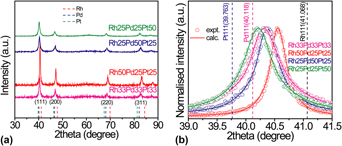Crossref Citations
This article has been cited by the following publications. This list is generated based on data provided by
Crossref.
Nakamura, Takahiro
and
Sato, Shunichi
2014.
Fabrication of Nano-scale Particles in a Laser-driven Reaction Field.
Materia Japan,
Vol. 53,
Issue. 11,
p.
533.
Sarker, Md. Samiul Islam
Nakamura, Takahiro
and
Sato, Shunichi
2015.
All-proportional solid-solution Rh–Pd–Pt alloy nanoparticles by femtosecond laser irradiation of aqueous solution with surfactant.
Journal of Nanoparticle Research,
Vol. 17,
Issue. 6,
Niu, Kai‐Yang
Fang, Liang
Ye, Rong
Nordlund, Dennis
Doeff, Marca M.
Lin, Feng
and
Zheng, Haimei
2016.
Tailoring Transition‐Metal Hydroxides and Oxides by Photon‐Induced Reactions.
Angewandte Chemie,
Vol. 128,
Issue. 46,
p.
14484.
Niu, Kai‐Yang
Fang, Liang
Ye, Rong
Nordlund, Dennis
Doeff, Marca M.
Lin, Feng
and
Zheng, Haimei
2016.
Tailoring Transition‐Metal Hydroxides and Oxides by Photon‐Induced Reactions.
Angewandte Chemie International Edition,
Vol. 55,
Issue. 46,
p.
14272.
Marzun, Galina
Levish, Alexander
Mackert, Viktor
Kallio, Tanja
Barcikowski, Stephan
and
Wagener, Philipp
2017.
Laser synthesis, structure and chemical properties of colloidal nickel-molybdenum nanoparticles for the substitution of noble metals in heterogeneous catalysis.
Journal of Colloid and Interface Science,
Vol. 489,
Issue. ,
p.
57.
Zhang, Dongshi
Gökce, Bilal
and
Barcikowski, Stephan
2017.
Laser Synthesis and Processing of Colloids: Fundamentals and Applications.
Chemical Reviews,
Vol. 117,
Issue. 5,
p.
3990.
Moniri, Samira
Reza Hantehzadeh, Mohammad
Ghoranneviss, Mahmood
and
Asadi Asadabad, Mohsen
2017.
Au-Pt alloy nanoparticles obtained by nanosecond laser irradiation of gold and platinum bulk targets in an ethylene glycol solution.
The European Physical Journal Plus,
Vol. 132,
Issue. 7,
Herbani, Y
Nakamura, T
and
Sato, S
2017.
Silver nanoparticle formation by femtosecond laser induced reduction of ammonia-containing AgNO3 solution.
Journal of Physics: Conference Series,
Vol. 817,
Issue. ,
p.
012048.
Meader, Victoria
John, Mallory
Frias Batista, Laysa
Ahsan, Syeda
and
Tibbetts, Katharine
2018.
Radical Chemistry in a Femtosecond Laser Plasma: Photochemical Reduction of Ag+ in Liquid Ammonia Solution.
Molecules,
Vol. 23,
Issue. 3,
p.
532.
Sarker, Md. Samiul Islam
Nakamura, Takahiro
Hossain, Ali
Kozawa, Yuichi
and
Sato, Shunichi
2019.
Nonlinear optical properties of Rh–Pd and Rh–Pt solid-solution alloy nanoparticles prepared by a laser-induced nucleation method in aqueous solution.
OSA Continuum,
Vol. 2,
Issue. 10,
p.
2891.
Sarker, Md Samiul Islam
Nakamura, Takahiro
Kameoka, Satoshi
Hayasaka, Yuichiro
Yin, Shu
and
Sato, Shunichi
2019.
Enhanced catalytic activity of inhomogeneous Rh-based solid-solution alloy nanoparticles.
RSC Advances,
Vol. 9,
Issue. 66,
p.
38882.
Reichenberger, Sven
Marzun, Galina
Muhler, Martin
and
Barcikowski, Stephan
2019.
Perspective of Surfactant‐Free Colloidal Nanoparticles in Heterogeneous Catalysis.
ChemCatChem,
Vol. 11,
Issue. 18,
p.
4489.
Hung, Shih-Hsuan
Akiba, Hiroshi
Yamamuro, Osamu
and
Ozaki, Taisuke
2020.
Structural investigation of ternary PdRuM (M = Pt, Rh, or Ir) nanoparticles using first-principles calculations.
RSC Advances,
Vol. 10,
Issue. 28,
p.
16527.
Vedyagin, Aleksey A.
Shubin, Yury V.
Kenzhin, Roman M.
Plyusnin, Pavel E.
and
Stoyanovskii, Vladimir O.
2020.
The Attractiveness of the Ternary Rh-Pd-Pt Alloys for CO Oxidation Process.
Processes,
Vol. 8,
Issue. 8,
p.
928.
Garip, Ali Kemal
and
Göcen, Tuğba
2021.
Investigation of the chemical ordering for PdnPt(32−n)Rh6 nanoalloys in TO structure.
International Journal of Modern Physics C,
Vol. 32,
Issue. 07,
p.
2150092.
Nakamura, Takahiro
2022.
High-Energy Chemistry and Processing in Liquids.
p.
21.
Nakamura, Takahiro
Yamazaki, Yuki
and
Sato, Shunichi
2022.
Synthesis of Noble Metals and Their Alloy Nanoparticles by Laser-Induced Nucleation in a Highly Intense Laser Field.
KONA Powder and Particle Journal,
Vol. 39,
Issue. 0,
p.
110.
Frias Batista, Laysa M.
Nag, Ashish
Meader, Victoria K.
and
Tibbetts, Katharine Moore
2022.
Generation of nanomaterials by reactive laser-synthesis in liquid.
Science China Physics, Mechanics & Astronomy,
Vol. 65,
Issue. 7,
Gebre, Shushay Hagos
2022.
Synthesis and potential applications of trimetallic nanostructures.
New Journal of Chemistry,
Vol. 46,
Issue. 12,
p.
5438.
Watanabe, Atsuya
and
Yatsuhashi, Tomoyuki
2023.
Fabrication of FeCoNi medium-entropy alloy nanoparticles by high-repetition-rate UV picosecond laser ablation in water.
Journal of Alloys and Compounds,
Vol. 950,
Issue. ,
p.
169896.





